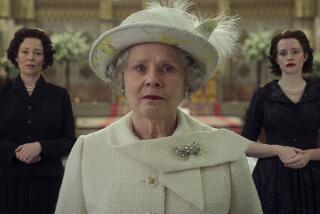Drama! Egos! Fighting! And All Backstage
- Share via
It can’t possibly surprise anyone that the Royal Opera House in London--where opera or ballet is staged most days of the year, where artists and administrators duke it out the way artists and administrators always do, where big stars parade their big egos the way they always do, where money is an ever-present worry--has its share of backstage dramas. But it has taken a British documentary crew, which spent a year hanging around the opera house in Covent Garden, to demonstrate that cultural institutions are just as fertile subjects for video voyeurism as hospitals, courtrooms and police stations.
“The Royal Opera House,” a six-part series to be broadcast on KCET beginning tonight at 8, caused quite a stir in Britain when it first aired on the BBC last year. Viewers couldn’t get enough of this fly-on-the-wall stuff. Whose head would Keith Cooper, the elegant and arrogant director of public relations, have next? What would happen to that new production with the cocky young British director and the famous old-fashioned Russian maestro locking horns?
And how about that designer, Maria Bjornson, responsible for new productions for both the opera and ballet within two weeks of each other and so far behind schedule that she may be headed for a breakdown, not to mention cost overruns? “They really are bastards,” huffs the penny-pinching chairman, Sir James Spooner, about artists like Bjornson, “the way they kick us around.” (With delicious timing, just as this drama surrounding Bjornson’s surreal design for the Royal Ballet “Sleeping Beauty” unfolds on the third episode, May 22, the company will be presenting it as part of its tour to the Orange County Performing Arts Center.)
What fun it all is to go behind closed doors. And what a brilliant PR coup this show also is for Covent Garden. General Director Jeremy Isaacs, who runs the house--overseeing the Royal Opera, the Royal Ballet and the affiliated Birmingham Royal Ballet--complained in a British interview that the documentary didn’t turn out the way he had hoped when he allowed director Michael Waldman and his crew free rein. Isaacs said he expected they would merely follow the making of one production.
Still, he had to know that television wants to see dirty laundry aired, and however much he now protests, he also had to know that there is nothing to match shenanigans for creating publicity. He was, after all, the founder of Channel Four, Britain’s independent competitor to the BBC. He came to Covent Garden to modernize its image and to put it on firmer financial footing. Moreover, Isaacs recruited PR chief Cooper from the English National Opera, where he had given the feisty smaller company a provocatively sexy image.
Together, Isaacs and Cooper stage manage “The Royal Opera House” brilliantly. The firings that are displayed, the bitter union negotiations, even some bungling in casting appear as nothing more than symptoms of the sheer complexity involved in getting a production on stage and an audience into the theater. Especially well-presented are the conflicts such an arts institution invariably engenders when it has many masters.
Every episode cleverly intercuts two or three crises in modern TV-drama fashion, made all the more revealing because of brazen camera-work. It zooms in on the clean up after livestock have been on stage; it accompanies a soprano into the doctor’s office and peers down her suddenly swollen throat; it closes in on a surgeon’s knife cutting into the ankle of a dancer.
Yet despite such sensationalism, nothing really controversial is shown. When a representative of the orchestra complains to Isaacs about an incompetent conductor for “The Magic Flute,” no name is mentioned. (Andrew Parrott, a British early music specialist, was the unsuccessful conductor for the production.) Nor do we actually witness major temper tantrums.
Instead, we do get a genuine glimpse at some very interesting characters. If the filmmakers indicate little interest or knowledge of opera or ballet, that also means they are not distracted by the productions themselves, leaving plenty of time for other fascinations. For instance, there are those dueling bartenders, straight out of “Monty Python.” They work opposite ends of the crush bar and haven’t spoken to each other for 20 years. Or the cynical set painter, who’s seen it all and who has nothing but disdain for people who don’t realize that the theater is only an illusion.
Just, of course, like “The Royal Opera House.”
* “The Royal Opera House” airs for the next six Thursday nights, starting tonight at 8 on KCET Channel 28.
More to Read
The biggest entertainment stories
Get our big stories about Hollywood, film, television, music, arts, culture and more right in your inbox as soon as they publish.
You may occasionally receive promotional content from the Los Angeles Times.











